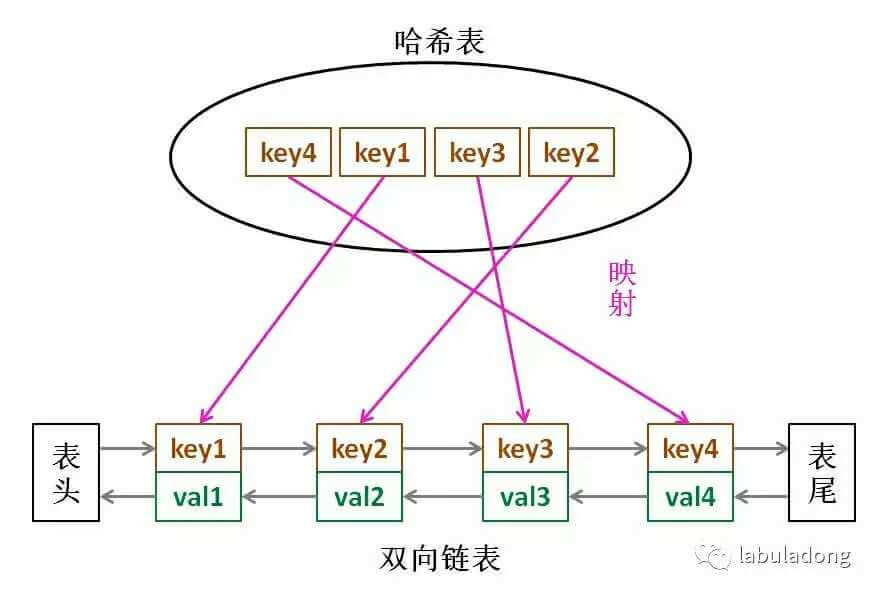 数据结构与算法--LRU算法
数据结构与算法--LRU算法
# 数据结构与算法--LRU算法
# 一、简介
LRU 的全称是 Least Recently Used(最近最少使用),是一种缓存淘汰策略,它是根据时间维度来选择将要淘汰的元素,即删除掉最长时间没被访问的元素据。它的底层是 哈希表 + 双链表 实现的,查找和添加的时间复杂度都是O(1),Java中的LinkedHashMap就是这样的一种数据结构。

剑指 Offer II 031. 最近最少使用缓存 (opens new window)
# 二、LRU算法的代码实现
# 2.1、双链表的节点类
class DLinkedNode{//双链表节点类
int key,val;
DLinkedNode pre,next;
public DLinkedNode(int _key,int _val){
this.key = _key;
this.val = _val;
}
}
1
2
3
4
5
6
7
8
2
3
4
5
6
7
8
# 2.2、双链表的实现类
class DLinkedList{//双链表
DLinkedNode head,tail;//链表首尾结点
public DLinkedList(){
this.head = new DLinkedNode(-1,-1);
this.tail = new DLinkedNode(-1,-1);
head.next = tail;
tail.pre = head;
}
public void addToHead(DLinkedNode node){//将节点添加到头部
node.pre = head;
node.next = head.next;
head.next.pre = node;
head.next = node;
}
public void moveToHead(DLinkedNode node){//将某个访问后的节点添加到头部
removeNode(node);
addToHead(node);
}
public void removeNode(DLinkedNode node){//删除某个节点
node.pre.next = node.next;
node.next.pre = node.pre;
}
public DLinkedNode removeTail(){//删除尾部结点
DLinkedNode res = tail.pre;
removeNode(res);
return res;
}
}
1
2
3
4
5
6
7
8
9
10
11
12
13
14
15
16
17
18
19
20
21
22
23
24
25
26
27
28
29
30
31
32
33
34
2
3
4
5
6
7
8
9
10
11
12
13
14
15
16
17
18
19
20
21
22
23
24
25
26
27
28
29
30
31
32
33
34
# 2.3、put方法逻辑

public void put(int key, int value) {
DLinkedNode node = cache.get(key);
if(node == null){
//创建新节点
DLinkedNode newNode = new DLinkedNode(key,value);
//哈希表加入结点
cache.put(key,newNode);
//结点addToHead
linkedList.addToHead(newNode);
size++;
if(size > capacity){
//删除尾部结点
DLinkedNode tail = linkedList.removeTail();
//哈希表删除结点
cache.remove(tail.key);
size--;
}
}else{
node.val = value;
//结点moveToHead
linkedList.moveToHead(node);
}
}
1
2
3
4
5
6
7
8
9
10
11
12
13
14
15
16
17
18
19
20
21
22
23
2
3
4
5
6
7
8
9
10
11
12
13
14
15
16
17
18
19
20
21
22
23
# 2.4、完整实现
class LRUCache {
private Map<Integer,DLinkedNode> cache;//哈希表缓存
private DLinkedList linkedList;//双链表
private int size;//链表size
private int capacity;//链表容量
public LRUCache(int capacity) {
this.size = 0;
this.capacity = capacity;
this.cache = new HashMap<>();
this.linkedList = new DLinkedList();
}
public int get(int key) {
DLinkedNode node = cache.get(key);
if(node == null) return -1;
//节点moveToHead
linkedList.moveToHead(node);
return node.val;
}
public void put(int key, int value) {
DLinkedNode node = cache.get(key);
if(node == null){
//创建新节点
DLinkedNode newNode = new DLinkedNode(key,value);
//哈希表加入结点
cache.put(key,newNode);
//结点addToHead
linkedList.addToHead(newNode);
size++;
if(size > capacity){
//删除尾部结点
DLinkedNode tail = linkedList.removeTail();
//哈希表删除结点
cache.remove(tail.key);
size--;
}
}else{
node.val = value;
//结点moveToHead
linkedList.moveToHead(node);
}
}
class DLinkedList{//双链表
DLinkedNode head,tail;//链表首尾结点
public DLinkedList(){
this.head = new DLinkedNode(-1,-1);
this.tail = new DLinkedNode(-1,-1);
head.next = tail;
tail.pre = head;
}
public void addToHead(DLinkedNode node){//将节点添加到头部
node.pre = head;
node.next = head.next;
head.next.pre = node;
head.next = node;
}
public void moveToHead(DLinkedNode node){//将某个访问后的节点添加到头部
removeNode(node);
addToHead(node);
}
public void removeNode(DLinkedNode node){//删除某个节点
node.pre.next = node.next;
node.next.pre = node.pre;
}
public DLinkedNode removeTail(){//删除尾部结点
DLinkedNode res = tail.pre;
removeNode(res);
return res;
}
}
class DLinkedNode{//双链表节点类
int key,val;
DLinkedNode pre,next;
public DLinkedNode(int _key,int _val){
this.key = _key;
this.val = _val;
}
}
}
/**
* Your LRUCache object will be instantiated and called as such:
* LRUCache obj = new LRUCache(capacity);
* int param_1 = obj.get(key);
* obj.put(key,value);
*/
1
2
3
4
5
6
7
8
9
10
11
12
13
14
15
16
17
18
19
20
21
22
23
24
25
26
27
28
29
30
31
32
33
34
35
36
37
38
39
40
41
42
43
44
45
46
47
48
49
50
51
52
53
54
55
56
57
58
59
60
61
62
63
64
65
66
67
68
69
70
71
72
73
74
75
76
77
78
79
80
81
82
83
84
85
86
87
88
89
90
91
92
93
94
95
96
97
98
99
100
101
102
2
3
4
5
6
7
8
9
10
11
12
13
14
15
16
17
18
19
20
21
22
23
24
25
26
27
28
29
30
31
32
33
34
35
36
37
38
39
40
41
42
43
44
45
46
47
48
49
50
51
52
53
54
55
56
57
58
59
60
61
62
63
64
65
66
67
68
69
70
71
72
73
74
75
76
77
78
79
80
81
82
83
84
85
86
87
88
89
90
91
92
93
94
95
96
97
98
99
100
101
102
